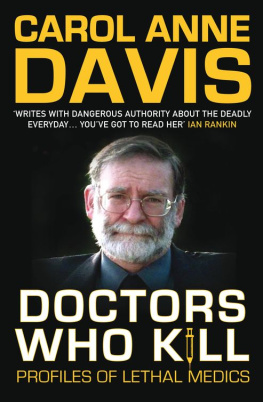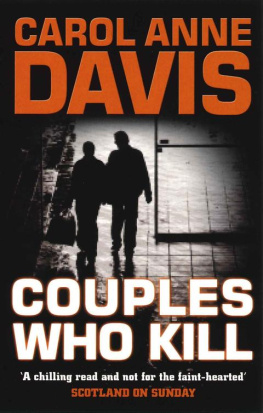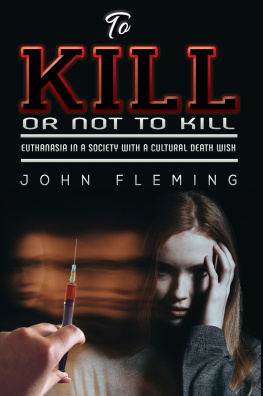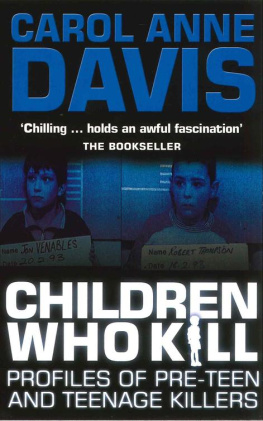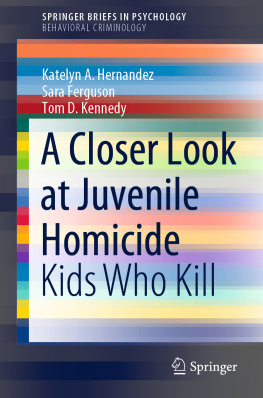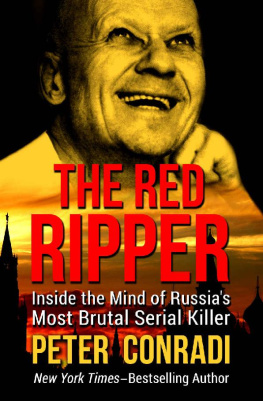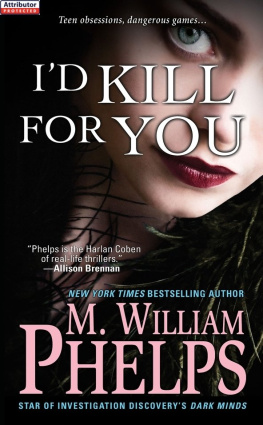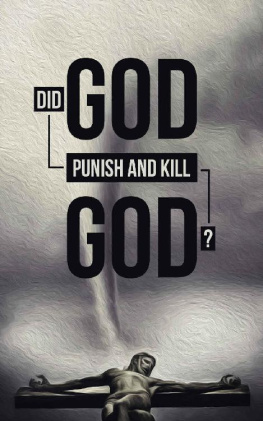Contents
1 The Hurting
Jesse Pomeroy
2 Pale Shelter
William Allnutt
3 Substitute
Cheryl Pierson & Sean Pica
4 I Am, I Said
Peter Dinsdale (aka Bruce Lee)
5 Dare To Be Different
Luke Woodham
6 Waiting For A Girl Like You
Cindy Collier & Shirley Wolf
7 Save Me
Robert Thompson & Jon Venables
8 Cant Get It Out Of My Head
Roderick Ferrell
9 Dont Cry Out Loud
Mary Bell
10 Under Pressure
Kip Kinkel
11 The Grass Wont Pay No Mind
Wendy Gardner & James Evans
12 Nobodys Child
Sean Sellers
13 Nineteenth Nervous Breakdown
Johnny Garrett
14 Senses Working Overtime
Recognised Typologies Of Children Who Kill
15 Cry Me A River
Further Classifications
16 Heard It Through The Grapevine
Children Who Kill Their Friends
17 Hungry Like The Wolf
Youthful Sex Killers
18 Born To Run
Children Who Kill Their Families
19 Alone Again, Naturally
Children Who Kill Again As Adults
20 Blame It On The Pony Express
The Scapegoats
21 Riders On The Storm
The Myth-Makers
22 Shes So Cold
Telling It Like It Is
Acknowledgements
Id like to thank Claire Rayner OBE for talking to me about the dangers of offering violence to children. Claire has published numerous books on medical issues and has been an energetic advocate of childrens rights throughout her life.
I also thank Ron Sagar MBE for answering my interview questions in depth and for providing unique details. As a Detective Superintendent, he interviewed Britains most prolific juvenile killer, Bruce Lee, at least twenty-eight times. With over thirty years experience in criminal investigation, Ron offered much insight into Bruce, a multiply-abused boy who claimed twenty-six lives.
I was similarly fortunate in interviewing Don Hale who fought for seven years to gain the freedom of the wrongly imprisoned Stephen Downing. Stephen was seventeen when he was jailed for a murder he didnt commit and was forty-four before his conviction was overturned and he was finally freed. As a result of his first class journalism on the case, Don Hale was made both Man Of The Year and Journalist Of The Year in 2000. Im delighted that he took time out of his busy schedule to contribute to this book.
Thanks also to crime writer David Bell for drawing my attention to an interesting case I hadnt heard of. David is author of the StaffordshireMurderCasebook,NottinghamshireMurderCasebook and LeicestershireMurderCasebook amongst others.
Most of my interviewees live in England, but my thanks extend overseas to Florida-based Lisa Dumond, a contributing editor to BlackGate and many other science fiction magazines. Though hard at work on her latest novel and busily promoting her existing novel Darkers Lisa helped me track down some vital criminal facts.
Im also grateful to the organisations which answered my questions and sent me invaluable reports, namely The Childrens Society, Children Are Unbeatable, Save The Children, Kidscape and The Howard League For Penal Reform. Finally, my thanks to The Home Office for providing me with year by year statistics of children who kill.
Preface
As a child, I was friends with a twelve-year-old boy who attempted to murder a slightly older girl. Theyd argued over which television programme to watch and he fetched a knife from the kitchen and thrust it deep into her back. Paul (not his real name) then left the room.
At first the girl thought that Paul had just punched her very hard. She felt ill and lay down on the settee on her stomach. When the pain intensified she looked back and saw the protruding handle of the knife.
The teenager staggered downstairs to alert a neighbour . Thankfully the neighbour left the weapon in situ if shed pulled it out, the girl would certainly have died. As it was, the blade had done irreversible damage to one of her lungs and she spent weeks in hospital, initially in intensive care. She later faced reconstructive surgery for the hole left in her back and had to take strong prescription drugs to help her sleep.
Twelve-year-old Paul now faced an attempted murder charge but numerous adults came forward to say what a polite and helpful boy he was. He belonged to a youth organisation and they too were very impressed with him. The judge recommended that he see a psychiatrist and the parents said that theyd arrange this, but didnt. His teenage victim was terrified that hed attack her again.
Its unclear how much the judge knew of Pauls background but I know that he and his siblings were regularly terrorised by their alcoholic father. He verbally mocked them and beat them with his belt. Pauls mother did nothing to stop these sessions, instead adopting a slightly martyred tone and telling anyone who would listen that her children were very polite to strangers and that she couldnt understand why they glared at her when they were at home.
In fairness, I really liked Pauls parents and spent as much time as possible with them. Both had the capacity to be kind and generous to a child who wasnt their own. Pauls mother cooked me excellent meals and both parents took me with them on family outings, adventures Id otherwise never have enjoyed. It was only in child-nurturing that they failed, presumably parenting as they had been parented.
Pauls attempted murder charge was just one of numerous instances of violence in my childhood so it quickly faded from my consciousness. I rarely thought of it again until halfway through writing this book. Only then did I realise that Pauls story had the same ingredients as almost every childs story that youll find here. That is, the child is physically and emotionally abused by an adult or adults, often the very people that created him. In turn, he or she goes on to perpetrate violence on someone else.
The children in this book tortured, burnt, battered, strangled or raped their victims victims aged from two years old to eighty. But these young killers had been tortured, burnt, battered, half strangled or raped before they carried out their pitiless acts.
The first two profiles are historic ones which demonstrate that children who kill arent a modern phenomenon brought about by horror videos or by single parent families. There are also brief details of other latter day killers in some of the sociological chapters , one of which bears a striking resemblance to the Robert Thompson and Jon Venables case.
The rest of the profiles are contemporary, featuring young killers from Britain and America whose ages range from ten to seventeen. But there are case studies in the later chapters involving younger children including a boy who killed at the age of three.
Several of the murders involve a sexual element, but as many readers find it difficult to understand how young children can become sexual predators, Ive incorporated a chapter on youthful sex killers which offers many more case studies. These killers are male but some were sexually molested by their mothers so the chapter also looks at female sex offending, an under-reported crime.
These crimes are horrifying but comparatively rare. Though the media likes to suggest otherwise, there isnt an epidemic of mini-murderers in Britain. To give some examples, in 1995 1996 there were 30 people under the age of eighteen convicted of murder in England and Wales. In 1996 1997 there were 19 and in 1997 1998 there were 13 such deaths. 1998 1999 saw 25 and the following year there were 23. These later numbers may rise as some cases are still being dealt with by the police and by the courts.


